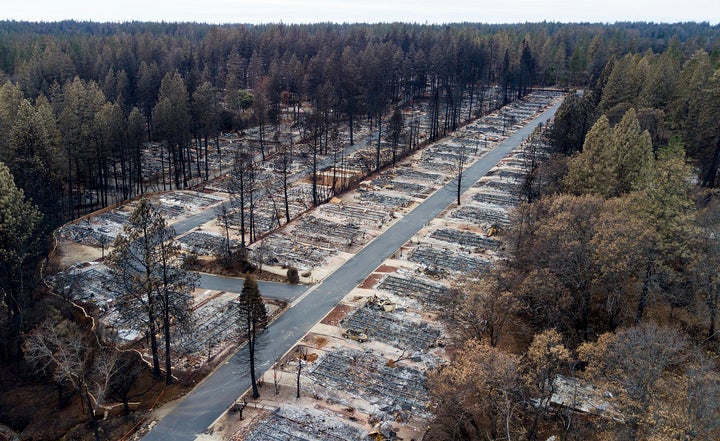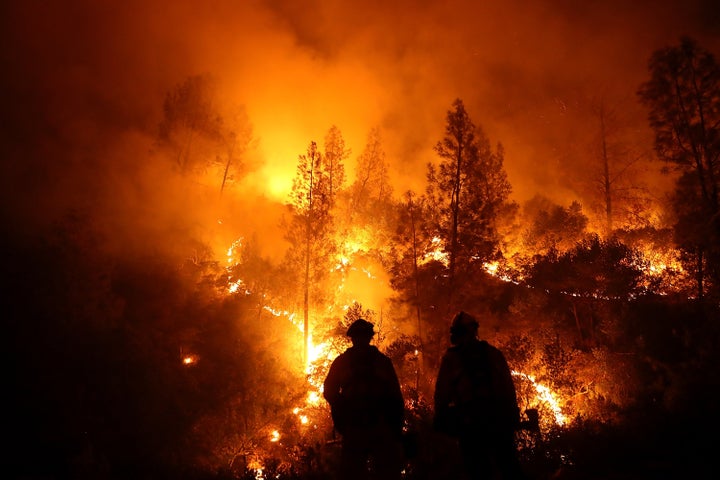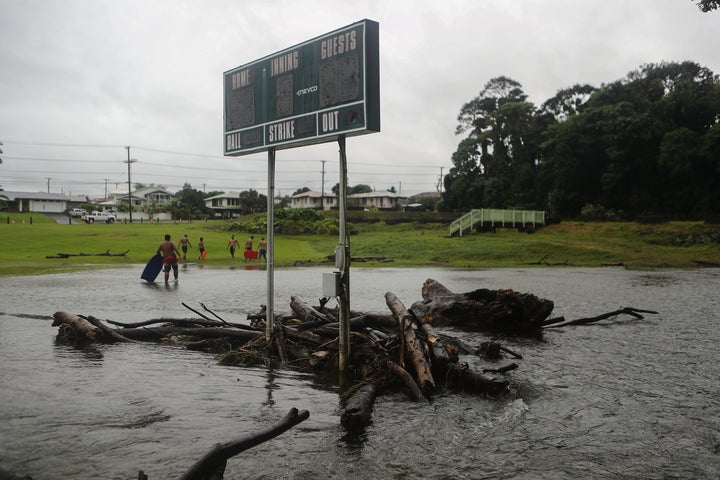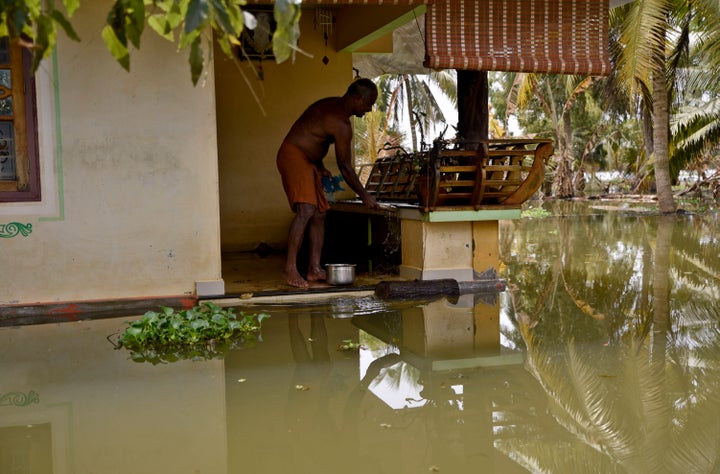It’s been a devastating year of natural disasters, from record-breaking wildfires tearing through California to two major hurricanes hitting the Southeast within a month ― and that’s just in the U.S.
Scientists have long warned of the dangers that a warming climate poses to our planet. This year alone, a United Nations report delivered a dire warning to countries to scale back greenhouse gas emissions before the effects of climate change become irreversible; and a federal climate report predicted the U.S. will warm at least 3 more degrees by 2100 unless fossil fuel use is curtailed. Meanwhile global carbon emissions were expected to reach a record high this year.
But the dire consequences of climate change are not just possibilities in a distant future ― they’re already here. While most scientists generally won’t attribute any single weather event or disaster to climate change, the scientific community, including experts at the National Oceanic and Atmospheric Administration, has warned that human-driven global warming influences extreme weather events ― for instance, more frequent and intense storms or wildfires.
“The impacts of climate change are no longer subtle. We’re seeing them play out, in real time, on our television screens and in our newspaper headlines,” Michael Mann, director of the Earth System Science Center at Penn State University, told HuffPost.
He noted that the “record floods, heat waves, droughts and wildfires” as well as “superstorms” seen over the past couple years have “as an underlying cause, the effects of climate change.”
“When it comes to the actions necessary to avert ever-more catastrophic climate change impacts, time is running out,” Mann added.
Here are some of the year’s major natural disasters that show the devastation of climate change is on our doorstep.
1. The deadliest wildfire in California history wiped out a town.

The Camp fire that wiped out the Northern California community of Paradise in November was the deadliest wildfire in the state’s history, killing 85 people. It was also California’s most destructive wildfire, destroying nearly 14,000 homes. Its death toll far surpassed that of the devastating fires in Sonoma and Napa counties last year, which left 44 people dead.
After Interior Secretary Ryan Zinke visited Paradise in November, he acknowledged that the “[fire] season is getting longer, the temperatures are getting hotter,” and noted this was his fourth visit in a year to California in response to wildfires. “Each trip, I say this is the worst fire I’ve seen,” he said. “We’re here today, and this is the worst I’ve seen.”
Yet he managed not to say the words “climate change” once, noting that “there’s a lot of reasons for a fire” and “now is not the time to point fingers.”
2. California also saw its largest ever wildfire.

From late July into August, the Mendocino Complex fire burned over 450,000 acres in Northern California, becoming the largest wildfire in state history. It surpassed last December’s Thomas fire, which previously held the record by burning over 280,000 acres in Southern California.
As of early December, California’s wildfires had burned more than 2 1/2 times as much area as they did by the same time last year. They’ve scorched more than 875,000 acres this year ― eclipsing the five-year average of about 230,000 acres burned.
Last year, which at the time was record-breaking, Cal Fire deputy chief Scott McLean had told HuffPost: “This is one of the worst fire years.”
This year he told HuffPost in November: “We’ve done away with the ‘new’ part of the ‘new normal,’” referring to the worsening fires in the state. He said the recent Camp fire had spread so fast that its flames burned up “the length of a football field in the matter of a second or two.”
3. Two devastating hurricanes hit the East Coast within a month.

Hurricane Florence hit the Carolinas in September, killing more than 50 people and bringing catastrophic damage along the coast followed by severe inland flooding.
Less than a month later, another major storm hit the Southeast: Hurricane Michael barreled into Florida, killing nearly four dozen people in Florida alone and wrecking entire coastal communities. The storm broke records as the first of its size to strike the Florida Panhandle since records began in 1851, according to The Washington Post and Weather.com.
The catastrophic hurricanes came almost exactly a year after Hurricane Maria devastated Puerto Rico, leaving the island without power for months and killing thousands.
4. Historic rains triggered floods and landslides in Hawaii.

In April, torrential rains poured down on the Hawaiian island of Kauai, triggering flooding and landslides and causing hundreds to evacuate their homes. “It’s the worst natural disaster to occur on Kauai in 25 years,” Sarah Blane, chief of staff to Kauai’s mayor, told HuffPost.
Months later, in August, Hurricane Lane, which was later downgraded to a tropical storm, tore through the Hawaiian Islands, dumping so much water on Hawaii that it earned a spot among the most extreme rainfall events on record in the U.S., according to the National Weather Service. The NWS pegged its rainfall as the third highest from a tropical cyclone in the U.S. since 1950. The No. 1 spot is held by Hurricane Harvey, which devastated Texas communities last year.
Lane triggered flash flooding across the Big Island, and also bore down on Oahu and Maui.
It’s rare for hurricanes to hit Hawaii, but scientists warn that warmer ocean temperatures linked to climate change could make such events more common.
5. A historic monsoon in India killed hundreds and displaced thousands.

In August, a severe monsoon hit the southern Indian state of Kerala, with heavy rains causing extensive flooding, landslides and building collapses. Hundreds of people died and thousands were left stranded on rooftops for days.
While monsoon floods occur every year in India, the severity of this year’s rainfall in Kerala was unprecedented.
“We’re witnessing something that has never happened before in the history of Kerala,” the state’s chief minister, Pinarayi Vijayan, told reporters.
6. Record rains in Japan triggered deadly landslides and flooding.

Torrential rains bore down on southwest Japan in July, causing rivers to overflow, setting off landslides, and killing more than 200 people. Millions were forced to flee their homes.
The country got three times more precipitation than was normal for July, Reuters reported.
“We’ve never experienced this kind of rain before,” a Japanese Meteorological Agency official told reporters. “This is a situation of extreme danger.”
7. A super typhoon hit a U.S. territory as the second strongest storm ever on U.S. soil.

In October, super Typhoon Yutu hit the commonwealth of the Northern Mariana Islands, a U.S. territory in the Pacific. It was one of the strongest recorded tropical cyclones to make landfall anywhere in the world.
With winds of up to 180 mph, it was the most powerful storm worldwide this year and the second strongest ever to hit U.S. soil, after the 1935 Labor Day hurricane in the Florida Keys.
Michael Lowry, a strategic planner for the Federal Emergency Management Agency, called it “one of the most intense tropical cyclones we’ve observed worldwide in the modern record.” The National Weather Service in Guam said it would “likely become the new yard stick by which future storms are judged.”

